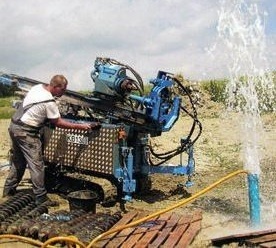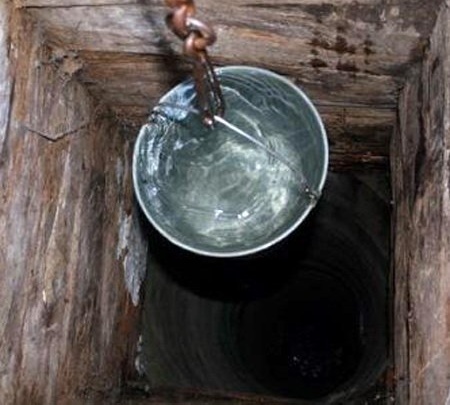Manual water well drilling: an overview of 4 methods + ice drilling in detail

Unfortunately, far from all areas have plumbing. The owners of such real estate have to choose an uncomfortable life "without amenities" or to conduct manual drilling of wells for water. This method can be considered the cheapest and most common way of arranging a source for autonomous water supply. Specialists are usually invited to carry out the work, but if desired, they can be completed independently. Today we will analyze how to drill a well with our own hands and what methods exist.
Content
Self Drilling Methods
Screw method
A very common method of drilling, most often used to equip shallow wells. Its essence is that with the help of auger blades the soil is destroyed and carried to the surface. There are two technologies for such drilling. For the first, a screw is used, the blades of which are welded to the base at a right angle. During operation, the blades cut the soil at an angle of 90 °, after which they are crushed and transported to the top. The main disadvantage of the method: part of the soil falls into the well and it needs to be removed to the surface.
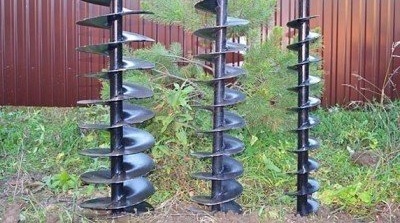
The soil-destroying auger tool blades can be welded to the axis at different angles, this fact does not affect the drilling technology. In any case, auger drilling is reminiscent of twisting a “corkscrew” with successive lifting of the destroyed rock
The second technology is more convenient. In this case, a screw with blades is used, which are welded to the pipe at an angle of 30-70 °. The device cuts the soil and, without crushing it, transports to the surface.
The advantage of the method is that in this case, nothing gets into the well. At an industrial drilling rig, the feed to the production of flushing fluid, most often water, is necessarily used. The jet pumped into the casing by the pump leaches the dump onto the surface. In the process of manual drilling, pump flushing is unlikely to be used. However, professionals recommend the use of flushing fluid, which greatly facilitates the drilling process.
Core drilling
Using this method, drilling is performed using a special tool, which is a pipe, at the end of which there is a core bit with sharp cutters made of strong metal. Superhard rock is first crushed with a chisel, then drilled with a crown and the sludge clogged into the core pipe is lifted.
The crown, rotating together with the pipe, goes deeper into the soil, forming a well of the corresponding diameter. Sludge collects inside the projectile and rises to the surface with it. By blows of a heavy sledgehammer, the hollow “glass” is freed from the rock.In the process of drilling a do-it-yourself well, inside the projectile water must be supplied either pure or mixed with clay. This strengthens the walls of the well and prevents their collapse.
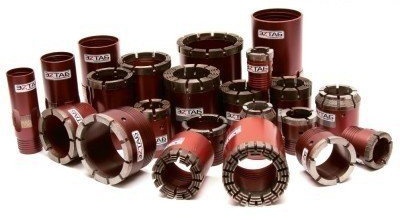
Column crowns can be of various types, their choice depends on the physical and mechanical characteristics of the rock in which the well is to be drilled
In its upper part, the core tube is equipped with fastening devices on which the rods are extended. This achieves the required drilling depth. Growth occurs in stages. After the first section of the pipe has been buried, a new rod is attached to it, the length of which is from 1.2 to 1.5 m. Then the actions are repeated. Thus, a process column is formed from the projectile and rods. It is very important that the glass and pipes are connected together as tightly as possible. At their attachment points, there should be no noticeable play and unwanted movements.
Shock-rope method
A heavy drilling tool rises to a height of 2 meters and lowers with force to the drilling site. He breaks the rock and captures it with a cutting-exciting device located on the lower edge of the pipe. It is called a bailer and can be of very different types, depending on the type of soil.
To facilitate the drilling process, a clay mixture or water is poured into the well, which is later scooped out using a special device made in the form of a bucket.
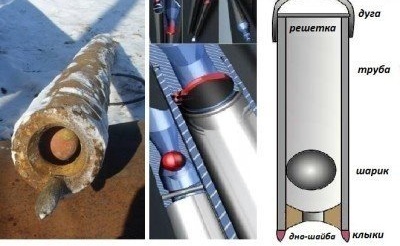
Diagram of a bailer with a ball valve, one of the types of tools specially designed for working with soft and loose soil
The shock-rope method involves the use of a tripod. It is being built over the drilling site. The height of the device is about two meters. A block is mounted on the top of the equipment through which the cable is thrown. At its end, the bobbin is firmly fixed. The tool rises to the surface of the earth and lowers into the well with a cable. Purification of the bilge from the sludge is carried out through a technological hole located half a meter from its lower edge.
Some craftsmen claim that they know how to manually drill a well, for which a tripod is not required at all. Long-term practice shows that this is possible only for depths less than 10 m and will require excessive physical effort from builders.
You can learn more about aquifer drilling technology from the following material:https://aquatech.tomathouse.com/en/vodosnab/kolod-skvaj/texnologii-bureniya-skvazhin.html
Rotational Impact Method
The method is very similar to the previous drilling method. The main difference: drilling rig performs immediately rotational and shock movements. Thus, the force applied to the projectile is increased and the drilling process is accelerated. The soil knocked out by the bailer is transported to the surface using a special bucket. The method is considered the best for arranging a well in stony hard soils.
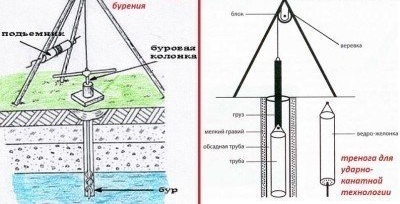
To facilitate the drilling process, a homemade tripod is used - a design with which it is much simpler and easier to remove a drill from a well
It should be noted that the least productive of all methods is a screw. However, it is the simplest, therefore it is precisely it that is most often chosen when they intend to drill a well on their own. However, the choice of drilling method also depends on the composition of the soil in the area. The screw method is most often useless on hard soils, and the use of rotational shock is inappropriate on soft soils. Thus, before you start drilling, you must definitely find out the composition of the soil on the site.
The following material will help swing the well after drilling:https://aquatech.tomathouse.com/en/vodosnab/kolod-skvaj/kak-raskachat-skvazhinu-posle-bureniya.html
Drilling a hole with an ice drill
There is a drilling method that will require minimal financial investment. This is manual drilling using an ice drill. The tool is used as a drill, and homemade rods are used to build it.

The ice ax knife will serve as a screw, and steel pipes with a diameter of up to 25 mm can be taken as extension rods. To make the process go faster, reinforced cutters are welded to the edges of the makeshift screw
In addition, casing pipes will be required to work to form a wellbore, a shovel and a device for removal from a section of sludge.
Drilling with an auger made from ice drills includes the following operations:
- Training. Digging a guide recess: a hole in two bayonets deep.
- We lower the drill into the resulting recess and begin to screw it into the ground using the rule of tightening the screws. It should be remembered that after every three or four turns, the tool is removed to the surface and cleaned.
- After the first meter is passed in depth, we begin the formation of the trunk. For this, the casing is lowered into the well, its diameter should be slightly larger than the diameter of the drill. It is best to choose lightweight plastic parts equipped with thread for joining.
- When the drilling tool begins to sink into the face to its full height, we attach an extension rod to it. There are two ways to do this: fasten the part if there is a thread, or add it using a steel pin-rod if it is missing.
- In the course of work, we continue to form the casing string. As soon as about 10-15 cm of pipe remains on the surface, we attach the following to it. The connection must be strong. Usually it is carried out using thread or soldering.
- Periodically check the verticality of the trunk. If the drill begins to beat against the walls of the casing, we level the structure using wedges made of wood. They clog between the ground and the casing.
- After water appeared in the well and a decision was made to stop the work, we install a filter and carefully fill the gap between the soil and the casing with gravel.
Casing can be mounted even after completion of drilling operations. In this case, plastic pipes are introduced into the well and connected in series after the previous part is lowered down. This is not the most rational way, since you will have to clean the bottom of the sludge again.
You can legitimize the use of a well by understanding the current legislation. Details:https://aquatech.tomathouse.com/en/vodosnab/kolod-skvaj/kak-uzakonit-skvazhinu.html
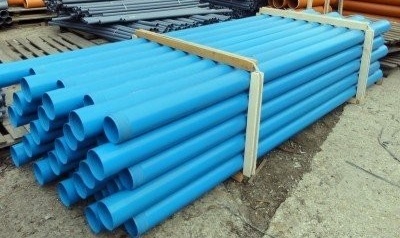
Plastic pipes are very light, quite durable and inexpensive, so they are most often chosen for arranging the casing of the well
Experience shows that do-it-yourself drilling is quite possible, albeit quite laborious. The matter should be taken with all responsibility: to choose the right method of drilling, choose the necessary materials, study the instructions and then get to work. The result of the effort will be clean water from your own well in the area.
